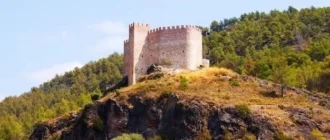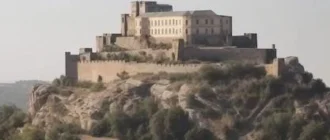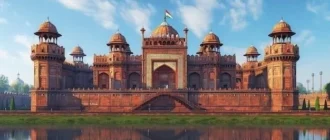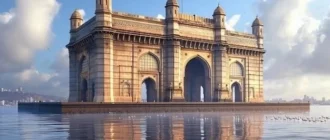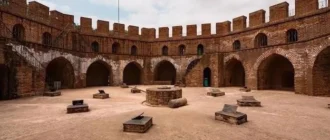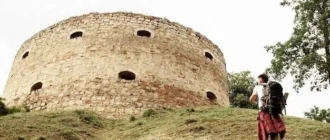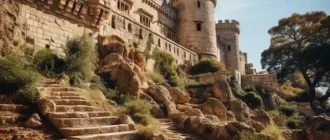As the capital city of Tanzania, Dodoma offers a unique blend of political significance and cultural heritage. The city boasts historical landmarks, religious sites, and natural attractions, making it an intriguing destination for travelers seeking a glimpse into Tanzania’s heartland.
Religious Sites
Dodoma’s religious landscape reflects the country’s diverse faiths, with places of worship serving various denominations. These sacred spaces offer visitors a glimpse into the spiritual life of the city’s inhabitants and often showcase impressive architectural design. Whether seeking a moment of quiet reflection or a deeper understanding of local beliefs, travelers will find a sense of serenity and cultural immersion within Dodoma’s religious sites. These sites stand as testaments to the enduring power of faith and the important role it plays in the lives of Dodoma’s residents.
Gaddafi Mosque
The Gaddafi Mosque, a prominent landmark in Dodoma, stands as a testament to the city’s political and religious significance. This architectural masterpiece, a gift from the late Libyan leader Muammar Gaddafi, is one of the largest mosques in sub-Saharan Africa. Its grandeur is evident in its towering minarets, expansive prayer hall, and intricate Islamic calligraphy adorning its walls. The mosque serves as a place of worship for Dodoma’s Muslim community and stands as a symbol of pan-African solidarity. Visitors, regardless of their faith, are welcome to admire the mosque’s architectural splendor from the outside, gaining a deeper appreciation for Islamic art and culture.
Historical and Cultural Landmarks
Dodoma’s historical and cultural landmarks offer a captivating journey through time, reflecting the city’s evolution from a colonial outpost to the nation’s capital. These sites stand as reminders of Tanzania’s rich history, showcasing its struggle for independence, its cultural heritage, and the legacy of its leaders. Visitors can explore these landmarks to gain a deeper understanding of Dodoma’s pivotal role in shaping the nation’s identity and aspirations. From grand squares to solemn monuments, these sites invite contemplation and offer a tangible connection to the past, fostering a greater appreciation for Tanzania’s journey as a nation.
Nyerere Square

Nyerere Square stands as a prominent landmark in Dodoma, named in honor of Julius Nyerere, the founding father of Tanzania. This expansive square serves as a hub of civic activity and a place for residents to gather and socialize. Its central location and historical significance make it a focal point of the city. Visitors to Nyerere Square can observe daily life in Dodoma and appreciate the significance of Julius Nyerere’s legacy in Tanzanian society. The square often hosts public events and celebrations, offering a glimpse into the vibrant cultural tapestry of the city.
Mnara wa Mashujaa (Monument of Heroes)
The Mnara wa Mashujaa, or Monument of Heroes, stands as a solemn tribute to the sacrifices made during Tanzania’s struggle for independence. This poignant landmark serves as a reminder of the courage and determination of those who fought for freedom. The monument’s design often incorporates symbolic elements that represent the values and aspirations of the nation. Visitors to the Mnara wa Mashujaa can pay their respects and reflect on the historical significance of the site, gaining a deeper understanding of the events that shaped modern Tanzania and the sacrifices made by its people.
Kondoa Rock Art Sites
A short distance from Dodoma lie the Kondoa Rock Art Sites, a UNESCO World Heritage Site, offering a captivating glimpse into Tanzania’s ancient past. These sites feature a remarkable collection of rock paintings, some dating back thousands of years, depicting scenes of hunting, rituals, and daily life. The Kondoa Rock Art Sites provide valuable insights into the beliefs, practices, and artistic traditions of early humans. Visitors can explore these well-preserved paintings, marvel at their intricate details, and appreciate the enduring legacy of human creativity spanning millennia.
Government and Institutional Buildings
As the capital of Tanzania, Dodoma is home to a collection of significant government and institutional buildings that reflect the country’s political system and national aspirations. These structures often showcase architectural styles that blend modern design with elements inspired by Tanzanian heritage. Beyond their administrative functions, these buildings stand as symbols of national unity and progress, representing the heart of Tanzania’s governance and decision-making processes. Visitors interested in understanding the inner workings of the Tanzanian government and its institutions will find these buildings to be of particular interest.
Bunge Tanzania Parliament Buildings
The Bunge Tanzania Parliament Buildings stand as a prominent symbol of Tanzania’s democracy, housing the nation’s legislative body. This complex of buildings serves as the platform for parliamentary debates, legislative processes, and decision-making that shapes the country’s future. The architecture of the parliament buildings often reflects a blend of modern and traditional Tanzanian design elements, symbolizing the nation’s progress while honoring its heritage. While access to certain areas may be restricted, visitors can appreciate the grandeur of the buildings from the outside, gaining a tangible sense of Tanzania’s political life.
University of Dodoma
The University of Dodoma (UDOM), one of Tanzania’s largest and most prestigious higher education institutions, stands as a testament to the country’s commitment to knowledge and human capital development. The university’s sprawling campus is a hub of academic activity, fostering innovation, research, and critical thinking. Visitors interested in experiencing campus life in Tanzania can explore the university grounds, observing the dynamic atmosphere and perhaps gaining insights into the academic pursuits of Tanzania’s future leaders. UDOM stands as a testament to the transformative power of education in Tanzania’s growth and development.

Parks and Gardens
Dodoma’s parks and gardens offer a welcome respite from the bustling city center, providing serene spaces for relaxation and recreation. These green oases showcase a variety of flora and fauna, highlighting the region’s natural beauty. Visitors can enjoy leisurely strolls, picnics under shady trees, or simply bask in the tranquility of these natural settings. Dodoma’s parks and gardens offer a refreshing change of pace from the urban environment, allowing visitors to connect with nature and enjoy moments of peace and quiet. These green spaces are essential to Dodoma’s urban landscape, enhancing the city’s livability and providing opportunities for residents and visitors to enjoy the outdoors.
SUA University Botanic Garden
The SUA University Botanic Garden, associated with the Sokoine University of Agriculture, offers a serene escape for nature enthusiasts and a valuable resource for botanical study. This meticulously curated garden showcases a diverse collection of plant species, both native to Tanzania and from other parts of the world. Visitors can stroll through themed gardens, observe medicinal plants, and learn about the importance of biodiversity conservation. The SUA University Botanic Garden serves as a tranquil oasis within Dodoma, offering educational opportunities and a peaceful retreat for those seeking respite from the city’s hustle and bustle.

Natural Attractions
Beyond its urban center, Dodoma is fortunate to be surrounded by breathtaking natural attractions that showcase the beauty and diversity of Tanzania’s landscapes. From vast national parks teeming with wildlife to imposing mountains offering panoramic views, these natural wonders provide a captivating escape for outdoor enthusiasts and nature lovers. Visitors seeking adventure and a deeper connection with nature will find an abundance of opportunities to explore the wilderness areas surrounding Dodoma, discovering hidden gems and experiencing the raw beauty of the Tanzanian wilderness.
Tarangire National Park
While not directly in Dodoma, Tarangire National Park, located a short distance away, is a must-visit destination for wildlife enthusiasts. This renowned park is famous for its large elephant herds, particularly during the dry season when they congregate around the Tarangire River. Visitors can embark on thrilling game drives, witnessing a diverse array of wildlife, including lions, leopards, giraffes, zebras, and a variety of bird species. Tarangire National Park offers a classic African safari experience, showcasing the raw beauty and abundant wildlife of Tanzania’s wilderness.
Mount Hanang
For adventurous travelers seeking a physical challenge and breathtaking views, Mount Hanang, located in the eponymous district near Dodoma, offers an unforgettable hiking experience. As the fourth highest mountain in Tanzania, Mount Hanang presents a rewarding climb through diverse landscapes, from lush forests at its base to rugged volcanic terrain near its summit. Hikers are rewarded with panoramic vistas of the surrounding plains and the opportunity to witness the mountain’s unique flora and fauna. Mount Hanang stands as a testament to the beauty and adventure that await those who venture beyond Dodoma’s urban center.
Markets and Shopping
Dodoma’s markets and shopping areas offer a vibrant glimpse into the city’s daily life and a chance to experience the local culture firsthand. From bustling open-air markets to modern shopping centers, visitors can find a variety of goods and souvenirs. Exploring these commercial hubs allows for engaging with local vendors, sampling regional delicacies, and discovering unique handicrafts. Whether seeking fresh produce, traditional fabrics, or handcrafted souvenirs, Dodoma’s markets provide a sensory-rich experience and an opportunity to interact with the heart of the city’s commerce.
Kisasa Market
Kisasa Market stands as a vibrant hub of commerce in Dodoma, offering a glimpse into the daily life and entrepreneurial spirit of its residents. This bustling market is a sensory experience, with vendors showcasing a colorful array of goods, from fresh produce and spices to clothing, electronics, and household items. Visitors to Kisasa Market can immerse themselves in the lively atmosphere, practice their bargaining skills, and discover unique souvenirs. Beyond its commercial significance, Kisasa Market provides a fascinating insight into the heart of Dodoma’s community, where locals gather to trade, socialize, and share in the daily rhythm of life.
Other Points of Interest
Beyond its well-known landmarks and attractions, Dodoma offers a collection of hidden gems and unique points of interest that cater to a variety of interests. These lesser-known spots provide a glimpse into the city’s diverse cultural tapestry, historical significance, and natural beauty. Visitors seeking off-the-beaten-path experiences can discover hidden architectural gems, delve into local art scenes, or simply soak in the city’s authentic ambiance. These hidden points of interest add depth and character to Dodoma’s tourism offerings, inviting exploration and a deeper appreciation for the city’s unique charm.

Dodoma Cathedral
Dodoma Cathedral, a significant landmark in the city’s religious landscape, stands as a testament to the enduring presence of Christianity in Tanzania. This imposing cathedral, often belonging to the Catholic denomination, serves as a place of worship for Dodoma’s Christian community and a symbol of faith and spiritual devotion. Visitors, regardless of their religious background, can appreciate the cathedral’s architectural grandeur and serene ambiance. The intricate details of its façade, the stained glass windows depicting biblical scenes, and the peaceful atmosphere of its interior offer a moment of reflection and a glimpse into the city’s spiritual side.

Simba Hill
Simba Hill, often referred to as Lion Rock due to its resemblance to a resting lion, offers a unique vantage point for panoramic views of Dodoma and its surroundings. This prominent hill, located on the outskirts of the city, provides a welcome respite from the urban environment and an opportunity to connect with nature. Visitors can embark on a leisurely hike to the top of Simba Hill, enjoying the fresh air and scenic trails. The summit rewards hikers with breathtaking vistas of Dodoma’s cityscape, the vast plains beyond, and the majestic Mount Hanang in the distance.
Museum of Geosciences Dodoma
The Museum of Geosciences in Dodoma offers a fascinating journey into Tanzania’s geological wonders and the history of the Earth. This specialized museum showcases a diverse collection of rocks, minerals, fossils, and exhibits that highlight the country’s rich geological heritage. Visitors can explore displays explaining Tanzania’s geological formations, learn about the processes that have shaped the Earth’s surface over millions of years, and discover the significance of geological resources in Tanzania’s development. The Museum of Geosciences provides a captivating educational experience for visitors of all ages, fostering a deeper understanding and appreciation for the Earth’s geological marvels.

Statue of Julius Nyerere Dodoma
The Statue of Julius Nyerere stands as a prominent landmark in Dodoma, honoring the legacy of Tanzania’s founding father. This imposing statue, often located in a central square or public space, depicts Nyerere in a dignified pose, symbolizing his leadership, vision, and enduring impact on the nation. The statue serves as a reminder of Nyerere’s instrumental role in Tanzania’s independence movement, his commitment to pan-Africanism, and his socialist ideals that shaped the country’s early development. Visitors to the statue can pay their respects to this iconic figure and reflect on his profound influence on Tanzania’s history.


